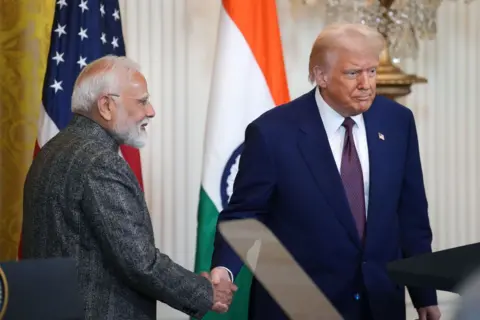On August 6, 2025, U.S. President Donald Trump took significant steps to enforce trade policy by issuing an executive order imposing a hefty additional tariff of 25% on Indian imports of Russian oil. As a result, the total tariff on Indian goods entering the United States will elevate to a staggering 50%, marking one of the highest duties currently levied by the U.S. government. This measure is seen as part of a broader effort to counter Russian aggression in Ukraine and to protect U.S. national security interests.
The executive order outlines that this new tariff will take effect for goods consumed or withdrawn from warehouses 21 days after the issuance of the order, specifically beginning at 12:01 a.m. Eastern Daylight Time. This timeline gives both the U.S. and India a brief opportunity to assess the potential repercussions of such trade measures, particularly considering the geopolitical tensions surrounding Russia’s military activities.
President Trump has publicly criticized India’s purchasing decisions, expressing that the nation shows a blatant disregard for the human cost associated with the ongoing conflict in Ukraine. He stated, “India doesn’t care how many people in Ukraine are being killed by the Russian War Machine,” emphasizing that the U.S. view on international partnerships, especially in the current conflict in Europe, has a profound impact on foreign policy decisions.
The White House issues a statement indicating that the actions of the Russian Federation in Ukraine pose an ongoing and significant threat to American security and necessitate urgent measures. According to the statement, India’s continued importation of Russian oil directly undermines U.S. efforts to address these global concerns. Furthermore, the administration contends that India’s actions, which include the resale of Russian oil, facilitate the economic means by which Russia funds its aggressive military operations.
As part of this effort to deter support for the Russian economy, the U.S. government plans to monitor not only India’s transactions but also other nations that import Russian oil. Recommendations for further actions are expected to be communicated directly to President Trump as necessary, reflecting an evolving strategy responsive to the complex geopolitical landscape.
This new tariff comes amid ongoing diplomatic efforts led by Trump’s envoy, Steve Witkoff, who has been in Moscow to seek avenues for peace between Russia and Ukraine. However, these negotiations are undercut by the hardline stance taken by the U.S. against countries that continue commercial ties with Russia, particularly amidst a backdrop of heightening tensions.
India, which has previously described the U.S. tariff threats as “unjustified and unreasonable,” responded by defending its position. A spokesperson from India’s foreign ministry, Randhir Jaiswal, noted that the U.S. had encouraged India to strengthen its energy imports from Russia amid the immediate chaos following the outbreak of war in Ukraine. Jaiswal emphasized that India’s pivot towards Russian energy was a necessary response to the alteration of global energy supply chains, where traditional fuel sources were redirected to Europe.
Furthermore, India’s criticism extends to the perceived hypocrisy of U.S. trade practices, citing that even while imposing tariffs on Indian oil purchases, the U.S. has continued to engage in trade with Russia. Reports indicate that last year, the U.S. managed trades valued at approximately $3.5 billion with Russia despite the existence of intense sanctions.
India’s stance, defined by its commitment to preserve national interests and economic security, suggests that it will make strategic adjustments to its energy sourcing and trade policies in response to U.S. tariffs. The foreign ministry underlines that like any major economy, India will take necessary measures to ensure its economic stability in the face of external pressures.
In conclusion, Trump’s decision to levy a hefty tariff on Indian imports of Russian oil is a bold move that signals not only the ongoing friction between the U.S. and Russia, but also an increasingly complex dynamic in U.S.-India relations as it navigates energy security amidst geopolitical tensions.











